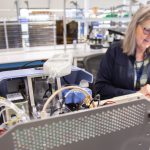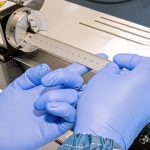Additive Manufacturing Techniques for Medical Devices
Modern medical device manufacturing utilizes a variety of methods for prototype development and high-quality biomedical products. As device needs become more complex, speed to market becomes essential and parts develop at a higher quality, additive manufacturing has quickly established itself as a standard process for prototype production and medical device manufacturing.
Additive manufacturing (AM) is synonymous with 3D printing, used in a variety of developments and applications. In the medical field, AM utilizes biocompatible materials such as metal alloys to create devices, implants and even human tissue. Medical device production is optimized with additive manufacturing techniques to create high-quality, complex parts quickly and cost-effectively.
Using CAD software, AM can build out layers and complex designs to assist engineers in creating prototypes or parts that would otherwise take excessive time and energy to make. By using additive manufacturing techniques for medical devices, engineers are able to increase the quality and optimize the performance of our partners’ projects.
Material Extrusion
Material extrusion is one of the more common additive manufacturing techniques for medical devices. Used for rapid prototyping or even for hobby 3D printing, material extrusion is fast and relatively inexpensive. By reading the CAD file, the 3D printer feeds material filament through a nozzle capable of moving on an X, Y and Z axis.
Once the first layer is created, the printer repeats the layering process continuously, fusing the layers together as it goes. Material extrusion enables engineers to get a device or part in hand sooner, and can use the part to apply testing or further ideation more effectively. While this is an excellent technique for the early stages of development, material extrusion typically is less reliable and durable as other additive manufacturing techniques.
Binder Jetting
Binder jetting, also referred to as ink jetting, is another cost-effective method for additive manufacturing. Using affordable and durable materials such as sand, ceramics and metals, binder jetting creates a powder and spreads it over a bed to form a layer from the CAD file.
During the process, the machine will apply a liquid binding agent to the powder. Once the part or device is completed, necessary post-processing steps such as sintering for metal materials are applied. These steps ensure the quality and durability of the final product. Because the material is strong and simultaneously lightweight, binder jetting products can be used for more permanent needs in some cases.
Directed Energy Deposition
Finally, one of the more accurate. high-quality additive manufacturing techniques for medical devices is Directed Energy Deposition (DED). Just like its counterparts, DED deposits material on three axes to create complex parts and devices. Through the Directed Energy Deposition process, materials are melted through the nozzle and solidify onto their printing surfaces.
DED utilizes either wire or powder materials, depending on project needs. These machines are highly accurate, and they enable the creation of larger parts and devices. By implementing different materials, Directed Energy Deposition can create large, complex parts with a high degree of accuracy and durability. The materials engineers use for these parts are often biocompatible, meaning they can be used in final projects such as implements or patient technology.
Modern Manufacturing at the Highest Standards
Additive manufacturing has become an industry standard for medical device development. Its versatility, reliability and speed enable engineers and developers to get prototypes and products in hand faster. Through refined layering processes, 3D printing has changed the way device manufacturing is done, and it has improved many processes and standards that are used every day.
At Nextern, we use the latest technology and additive manufacturing techniques to ensure the parts and devices we create are of the highest quality. Our ability to create prototypes from a variety of materials and manufacture complex parts in-house has raised our standards for better products. Contact us to learn how we can power your device using highly accurate and reliable technology.







